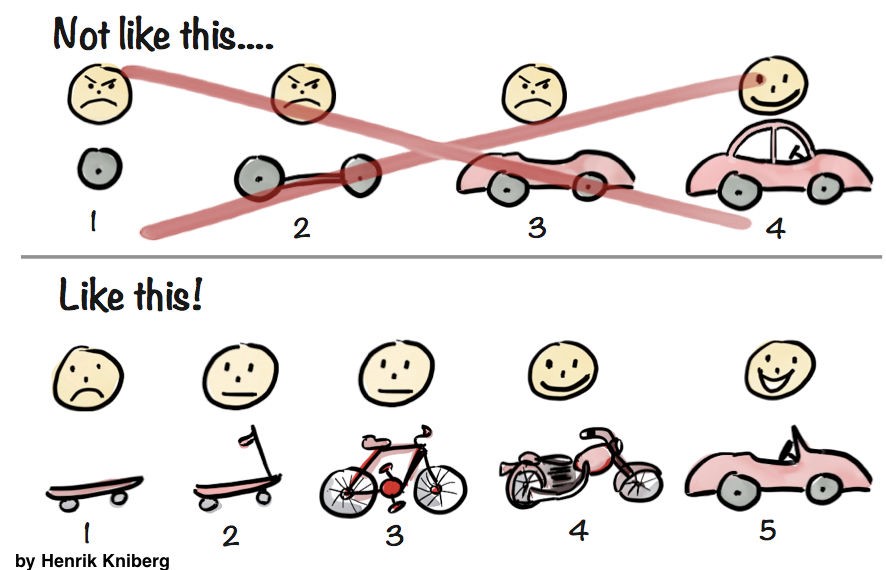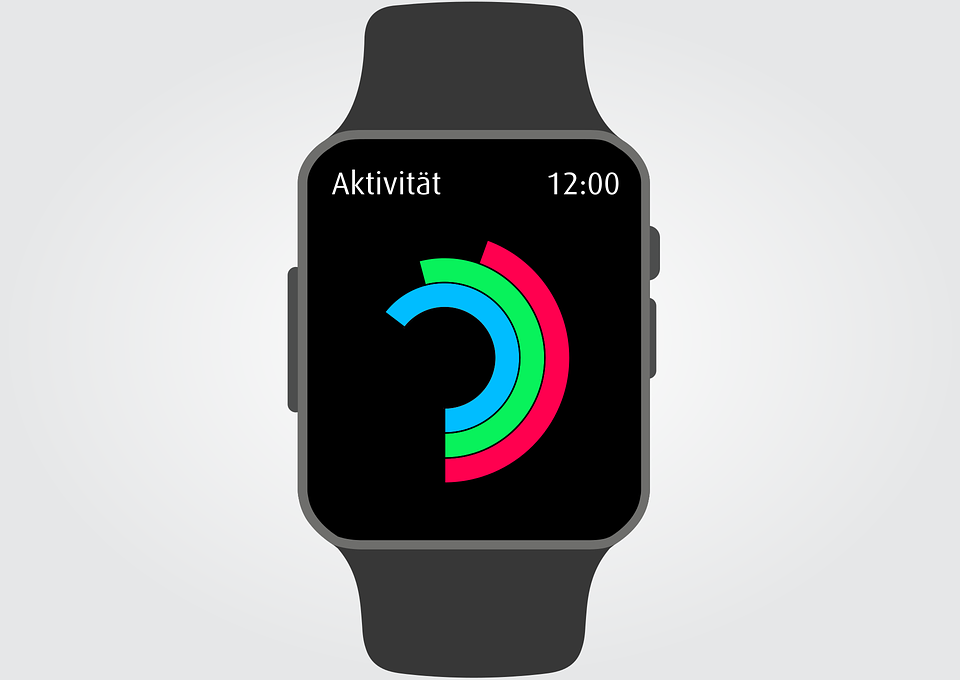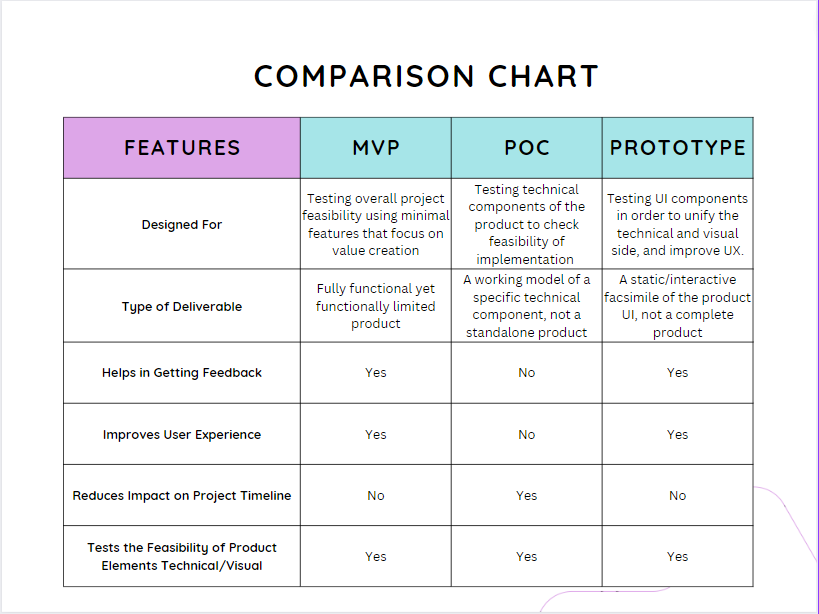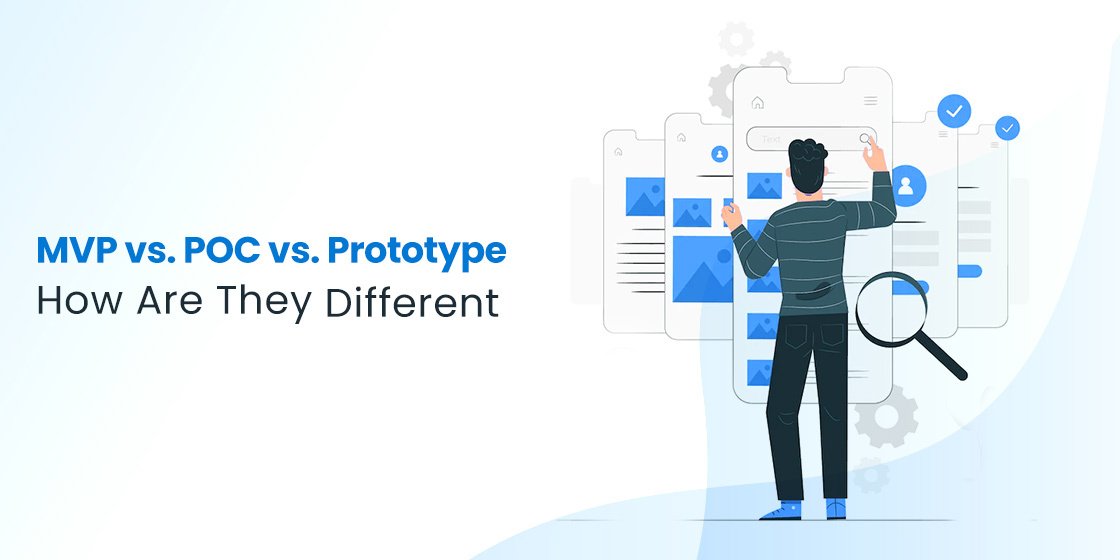Table Of Content
Identifying What Sets Prototypes, MVPs, and POCs Apart, and Choosing What to Use
Many factors dictate the success of a software product, including a mix of careful and comprehensive testing and the right market fit. On the first step on this journey towards success often starts by validating the idea you want to develop in the first place.
When you approach a custom software development company with your new idea for a software, you will often hear words like MVP, prototype, and POC thrown around. And it is understood that before the project can be developed completely, some of these elements need to be considered.
But what are they? What does each of these terms mean, and how are they different from one another? And most importantly, which of these do you need for your project?
Do not worry, we have you got you covered. Let’s dive and discuss each of these terms in detail, before moving on to how their differences, and discovering where each of these elements is used in a project lifecycle.
What Defines an MVP?
Lets start out with the one that you might have heard quite frequently – MVP. MVP is short for “Minimum Viable Product”. Essentially, it can be considered a kind of sample of the prospective project, with just enough features to make it functional.
That is why you will often hear different classifications or definitions for an MVP, because an MVP differs significantly from project to project. You can say that the definition of a minimum viable product may even differ within the same organization when discussing two different project.
That is because based on your project needs and idea, the number of features and functionality you consider for your MVP might be equal to a complete project for another organization. In the end, it boils down to how your MVP is providing value to the end user while validating your idea.
Let’s take a look at this image by Henrik Kniberg, which tries to explain the concept of an MVP in terms of value provision.

Source: Interaction Design Organization
In this image, we are looking at an MVP for a project where the purpose is to provide a motorized mode of transport to the users. In the upper row, we can see that while its true that a wheel is an essential feature to this value realization, it cannot be considered an MVP on its own.
That means that the proposed MVP fails to offer the required value. On the other hand, the lower row depicts a somewhat closer depiction of an MVP, where the fourth iteration can be considered as proving the idea as feasible, and offering value at the same time.
So, we can say that creating an MVP requires balancing the minimum amount of features to add, while still validating your idea and providing value. That last part is crucial, as that is what stops your MVP from being considered an inferior or incomplete product, one of the most important distinctions in SaaS software development.
Elements That Make Up a Minimum Viable Product?
There are a lot of features and elements that define an MVP, or a minimum viable product. Lets take a look at some of its most important elements to see what defines the MVP.
Used to Get User Feedback
Developing an MVP is a surefire way to get relevant feedback from your prospective users easily and quickly. Then, you can use that feedback to incorporate the changes that users expect and desire, along with the additional features you planned to incorporate.
Saves Investment and Resources
As you only have to implement the core features of your app into your MVP, it saves a lot of time and other resources, including your precious capital. It allows you to test out a simpler version of your product to see if it is viable or not, before aligning the required resources for its comprehensive version, thus saving your software development cost, time, and capital.
Attracts External Sponsors and Investors
By allowing you to present your core functionality in a working model, it allows you to attract investors and others by showing them a proof of your idea’s viability. This way, you can get the necessary funds, distribution channels, and other resources you need to develop the full-fledged version of the app without issues.
Explaining Proof of Concept

As its name suggests, POC or Proof of Concept refers to a type of project development that focuses on the technical viability of your idea’s core functionality. It helps you understand if developing a feature will fall within the project constraints, such as time, quality, and cost, and is a very important tool for software development planning.
The idea behind it is that a POC is created for each complex element of a project. Therefore, we can say that for a highly complex project, there may be a number of POCs developed to test each of them separately.
Unlike MVPs though, a proof of concept is all about judging the technical merits of a feature. There is no place or consideration for user experience, as the process focuses on judging and validating the technical merits.
Therefore, the effort and time expended in ensuring a good user experience would be moot if at the end of the day your proof of concept fails to validate the feature in the first place.
What Features Define a POC?

Let’s look at some of the defining features of a proof of concept that differentiate it from the prototypes and minimum viable products.
Allows for Innovation
Innovation occurs where there is a fine balance between technical viability and market demand. Your proof of concept will help you determine if your novel approach to the app is something that is capable and feasible to build using the available technologies.
Saves Time in the Long Term
By testing and checking the core components in the form of proof of concepts right at the start, you can save a ton of time later on in the project. That is because you will already know the expected time and resources a module or feature may take, and based on that, you would have evaluated if it were feasible to add it to the project. And if it was feasible or necessary to add it, then this evaluation would help you prepare for it by doing staff augmentation or allocating more time to the module as needed.
Allows You to Choose the Ideal Technologies
One of the best things about using proofs of concepts is that it allows you to test the viability and suitability of different tech stack simultaneously. Let’s say you want to implement a feature in your app, and there are two different tech stacks or frameworks that could be used, let’s say between Django vs Laravel. Using POCs, you can implement it both ways to check which would be the more suitable technology for your product, easily.
Helps You Test Your Project Plan against the Competition
POCs also allow you to see how your competition is implementing a specific feature. If you think you could tweak your method or follow an entirely different pattern to implement the same thing in order to make it more suited to the users, then a proof of concept can help you test that.
Prototypes – What are They?

A prototype is somewhat similar to the POC concept we discussed earlier. However, one of the major differences is that this is where your products design is developed and tested. You can say that while a proof of concept assesses the technical side, a prototype assesses the visual aspect of the product. This makes it an important tool for the user experience of a software product.
In this type of product evaluation, as cross-functional team of designers, developers, and stakeholders like product owners sit together to see how the product will look, and how people will interact with it. They finalize the list of UI elements that are essential to the products user experience, while everything else besides those will be removed.
Prototypes come in many different forms. From simple, static wireframes, to complex and highly realistic and interactive UIs developed using tools like Figma. And one of the biggest reasons why people use Figma to create UIs, besides the interactive results, is that it generates HTML and CSS code directly when you design a layout. This code can be easily inserted within our own codebases, allowing for quicker app development. Plus, there are additional tools that offer a host of benefits, such as one that converts the components created in Figma into Flutter widgets.
The only downside however, is that it can take a longer amount of time to create a prototype, especially if there are a lot of tweaks or changes made to it.
Characteristics of a Prototype

Prototypes are one of the most common evaluation tools used in the industry today, with some companies focusing and using this process to tweak their designs for better success. Let’s look at some of the most common uses of a prototype.
Prioritize Your Design Elements
Often, popular trends influence the visual design of your product, especially during the ideation stage. However, many of these app and web design trends are not suitable for your actual product. By prototyping, you can choose what elements in your UI work, and discard the elements that don’t fit with your overall design.
Iterate Your Designs Easily
Digital Wireframing and prototyping tools allow designers to create multiple iterations of the project easily and in a relatively short amount of time. This can be a great help if you want to test out the impact of specific elements in your overall design by putting two different ones side-by-side.
Generate Feedback
Finally, UI is the most important element that can make or break your user experience. By prototyping, you can test out your product’s visuals to get valuable feedback, which could be used to improve your design according to the user perspective.
MVP vs. POC vs. Prototype – A Side-by-Side Comparison of the Three Concepts
Now that we have taken an in-depth look at each of these three evaluation tools, you might be wondering about the differences between the three. And while it may seem like there isn’t much of a distinction between them, this side-by-side comparison will help you understand it better.

Conclusion
In short, the MVP vs POC vs Prototype is a moot debate, especially if you know and understand the differences between the three. In fact, all three of them fulfill different duties in your software development lifecycle, and contribute the information required of them at those stages.
So, if you are looking to understand when and how to use an MVP, POC, or a prototype, the article above is a great place to start.
Frequently Asked Questions
| Is MVP the same as a prototype in agile? While they are both tools that are early, lightweight iterations of your final product, there is a discernible difference between the two concepts. An MVP is a bare-bone yet functional product, while a prototype is usually a simulation of the product in question, without any fully realized features. |
| What is the key difference between a POC and a prototype? A prototype is just a simulation of your idea, while a POC is a process or tool to validate your assumptions regarding the product being developed, so that you can assess if the product is feasible to develop. |
| What is an MMP? An MMP or a minimum marketable product is considered the next form of a MVP. Also called the MMR, or the minimum marketable release helps us figure out whether the idea we developed as an MVP is worth progressing. |
| What are the 4 types of prototypes used in the software industry? The four types of prototypes commonly used in the software development industry include: – Rapid/Throwaway prototyping – Evolutionary prototyping – Incremental prototyping – Extreme prototyping |
Empower your digital initiatives with BariTechSol, a premier custom software development company. Our skilled team tailors cutting-edge solutions to your unique needs. Elevate your tech experience and stay ahead in the digital realm. Partner with BaritechSol and code the success of your next big idea.


